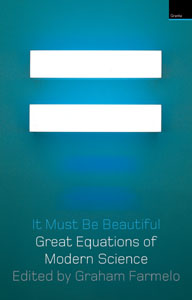edited by Graham Farmelo, Granta Books, ISBN 1 86207 479 8, £20.
In this lively volume of semipopular essays, 12 leading scientists, historians of science and science writers discuss “beautiful” equations of 20th-century science. Some of the essays are elegant and revealing discourses centring on the equations themselves; others are equally interesting but more historical in nature, sometimes verging on the biographical. Almost all are accessible to a broad audience with a little scientific background.

Roger Penrose and Frank Wilczek thoughtfully discuss the meaning of Einstein’s equations of general relativity and Dirac’s equation respectively. Steven Weinberg, in his extended afterword, also discusses the Dirac equation, and both Wilczek and Weinberg focus on how the equation has survived despite our significantly altered understanding of its meaning since Dirac’s time.
The meaning of the possibly less well known, but certainly beautiful, equations of Yang-Mills theory (as well as such topics as the Higgs mechanism) are also nicely introduced by Christine Sutton. Igor Aleksander provides a rewarding piece on Claude Shannon’s great work founding information theory, and John Maynard-Smith discusses some fascinating aspects of the theory of evolution (including his own use of the theory of games in evolution theory, to which this essay provides a good introduction), while Robert May introduces the deceivingly simple logistic equation with its chaotic solutions.
The essays from Graham Farmelo, Peter Galison, Aisling Irwin and Arthur Miller are also stimulating. Since they tended to be less centred on the equations, they leave room for dispute. For example, Arthur Miller makes a remark near the end of “Erotica, aesthetics and Schrodinger’s wave equation” (Schrodinger’s erotic life is endlessly fascinating to historians) that “the Heisenberg-Schroedinger dispute…was fundamentally one of aesthetic choice” and he points out that physicists use Schrodinger’s formalism rather than Heisenberg’s matrix mechanics for aesthetic reasons. But Born’s great work on the probability interpretation showed that Schrodinger’s interpretation of the wavefunction was incorrect, giving, for example, no understanding of the interference terms in a sum of wavefunctions. Furthermore, surely the reason Schrodinger’s wavefunction (given the correct interpretation) is so popular is because it is easier to use than matrix mechanics, and because it stimulates visualization in the reader, which ultimately leads to suggestions for applications.
Surprisingly, the contents include an essay on Drake’s equation. This is the formula for the number of technological civilizations in our galaxy, depending on such things as the rate of star formation, the likelihood of intelligent life evolving and, least knowable of all, the typical lifespan of a technological civilization. This sums up this collection nicely – you can expect to be entertained and informed in equal measure, often by surprise, and hopefully its success will lead to a second volume.








